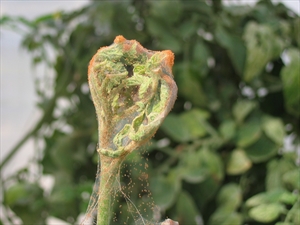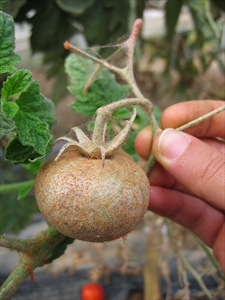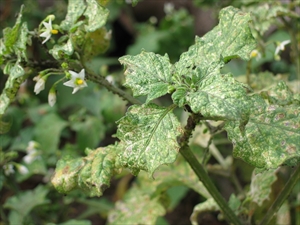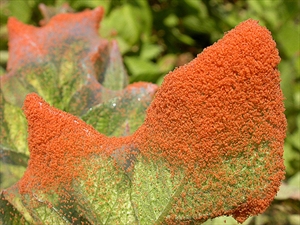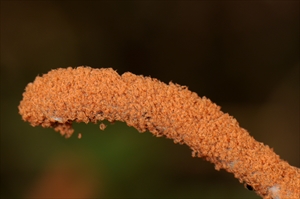Tomato red spider mite
Pacific Pests, Pathogens, Weeds & Pesticides - Online edition
Pacific Pests, Pathogens, Weeds & Pesticides
Tomato red spider mite (477)
Tetranychus evansi; previously known as Tetranychus takafujii. Note, it is similar to the two spotted mite, Tetranychus urticae (see Fact Sheet no. 024).
Asia, Africa, South and North America (including Hawaii), the Caribbean, Europe, Oceania. It is recorded from Australia and New Zealand. It is NOT recorded from Pacific island countries.
A wide host range, but mostly in the Solanaceae family, which includes capsicum, chillies, eggplant, potato, tobacco, tomato, and several weeds in the nightshade family. Less commonly, it is found on other families, e.g., beans, citrus, cotton, and ornamentals, e.g., roses.
A serious pest of tomato and other members of the potato family, both on indoor and field crops. The mites are difficult to see with the naked eye and better viewed with a hand lens or under a microscope.
Eggs are round, 0.1 mm diameter, orange to white, later grey before hatching into a larval stage with six legs (Photo 1). A moult produces orange to dark red nymphs which are smaller versions of the adults with eight legs. When adult, sexes differ in size and colour. Females are about 0.5 mm, oval, orange-red, darker at the sides of the body (Photo 2). Males about 0.3 mm long, yellowish-orange. Females lay up to 200 eggs.
Damage occurs mostly on young leaves, only occasionally on fruit (Photos 3-5). The mites can be found on both sides of the leaves, more on the underside, especially along the veins. Less intense infestations result in speckled tops of leaves caused by mites piercing the cells and sucking the sap on the undersides of leaves (Photo 6). More tense infestations, often accompanied by webbing, result in both sides of the leaves becoming whitish or yellowish, and eventually turning brown and falling.
Spread over short distances is on the wind, water and on clothing and tools. When populations are large and sap is depleted, the mites move to the top of plants for spread on the wind (Photos 7&8). Spread over long distances is via the trade in fruit, e.g., tomatoes on the vine, and via the domestic and international trade in plants.
Feeding from the mite can result in death of the host plant within 3-5 weeks after infestation. The mite is capable of inflicting significant economic impact through reduced yields and increased control costs. For instance, in Australia, some states list tomato red spider mite as a prohibited pest and should it arrive with infested produce from infested states considerable treatment costs would be incurred.
Because of the similarity of Tetranychus evansi to other red spider mites, e.g., the two-spotted mite (Tetranychus urticae), and the bean spider mite (Tetranychus ludeni), identification should be done by an expert.
BIOSECURITY
The risk of introduction is high. Countries not yet infested by tomato red spider mite should consider all likely pathways for entry, and apply quarantine measures accordingly. Particular attention should be given to the risks associated with the trade in fresh fruit and living plants.
An IPM APPROACH
An integrated pest management approach is needed to control tomato red spider mite. This involves crop hygiene through culling of nightshade and other Solanaceae weed hosts from the crop area and surrounds, encouragement of natural enemies and, if required, miticides.
NATURAL ENEMIES
Predatory mites keep populations of spider mites in check, as do ladybird beetles (see Fact Sheet no. 083), lacewing larvae (see Fact Sheet nos. 270&406), pirate bugs, big-eyed bugs (see Fact Sheet no. 370), and predatory thrips. Managing mites requires preserving natural enemies; in most cases this means doing nothing to harm them, such as using broard-spectrum pesticides (see Fact Sheet no. 472).
CULTURAL CONTROL
Before planting:
- Weed in and around nurseries, especially remove wild plants, e.g., nightshades and Amaranthus.
- Check plants in the nursery for mite infestations and, if present, do not plant in the field. Spray any infested plants (see below), or source propagating stocks from a reputable supplier.
- Do not plant new fields of susceptible crops next to those already infested; especially avoid continuous cropping of Solanaceous crops, e.g., capsicum, eggplant, potato, tomato.
- Do not plant downwind from infested crops: spider mites easily spread on the wind.
During growth:
- A regular spaying of leaves with water will keep spider mites in check, but this is not a practical solution for large plantings without a means of irrigation. However, the technique helps conserve natural predators.
- Weed: remove plants that are common hosts of spider mites, e.g., wild nightshades and Amaranthus (see above). These plants can sustain populations of mites between crop rotations.
-
Avoid water-stressed plants as they encourage mite outbreaks.
-
Put up farm biosecurity signs on gates and fences to manage visitors coming on your property. Ensure footwear, clothing and equipment of visitors and farm workers is free from soil and plant material before entering and leaving your property.
-
Teach farm workers what to look for and how to report mite symptoms.
After harvest:
- Plough in or collect and burn debris as soon as possible after final harvest.
CHEMICAL CONTROL
Tetranychus evansi is resistant to many acaricides and insecticides that are registered for use in Australian cropping systems.
- If pesticides are used, they should be applied carefully. Rotate between different chemical groups, to prevent resistance developing to any one of them. There are several products registered in Australia for use against red spider mites (abamectin, bifenthrin, chlorpyriphos, dimethoate, malathion), but note that they are toxic to natural enemies and that tomato red spider mite may tolerate them.
- Not all insecticides kill mites, and those that do may not kill all the stages. Eggs are particularly resistant to pesticides and so, too, are larvae and nymphs, especially when moulting, as they do not feed. More than one application is needed at 5-10 days apart.
- Use pesticidal oils (white oil based on vegetable oils), horticultural oil (based on petroleum oils) or soaps:
- Soaps:
- Use soap (pure soap, not detergent).
- 5 tablespoons of soap in 4 litres water, OR
- 2 tablespoons of dish washing liquid in 4 litres water.
- White oil (vegetable oil):
- 3 tablespoons (1/3 cup) cooking oil in 4 litres water.
- 1/2 teaspoon detergent soap.
- Shake well and use.
- Soaps:
-
For commercial products of horticultural oil, follow the instructions on the product label. Make sure the oil can be used on the crops of interest, otherwise it may damage the foliage. Spray the underside of leaves, as the oils must contact the mites.
-
Use products containing sulphur - a product allowed under organic certification.
-
Use abamectin, a product derived from a soil bacterium. It is absorbed into plants but is not systemic.
____________________
When using a pesticide, always wear protective clothing and follow the instructions on the product label, such as dosage, timing of application, and pre-harvest interval. Recommendations will vary with the crop and system of cultivation. Expert advice on the most appropriate pesticides to use should always be sought from local agricultural authorities.
AUTHOR Grahame Jackson
Information from Tomato red spider mite (2019) Business Queensland. Queensland Government. (https://www.business.qld.gov.au/industries/farms-fishing-forestry/agriculture/crop-growing/priority-pest-disease/tomato-red-spider-mite#:~:text=Tomato%20red%20spider%20mite%20(Tetranychus,legs%20and%20insects%20have%206); and Plant Biosecurity and Product Integrity (2018) Tomato red spider mite. Department of Primary Industries, NSW, Australia. (https://www.dpi.nsw.gov.au/biosecurity/plant/insect-pests-and-plant-diseases/Tomato-red-spider-mite); and Migeon A, Dorkfeld F (2020) Spider Mites Web: a comprehensive database for the Tetranychidae. (http://www1.montpellier.inra.fr/CBGP/spmweb); and from Maulana T, et al. (2016) Red spider mite on tomato. Pest management decision guide: green and yellow list. CABI Plantwise. (https://www.cabi.org/ISC/FullTextPDF/2016/20167801479.pdf). Photos 2-7 Alain Migeon INRA, UMR CBGP (INRA/IRD/Cirad/Montpellier SupAgro), Campus International de Baillarguet, CS 30016, 34988, Montferrier-sur-Lez Cedex, France. Photos 1&8 Ray & Elma Kearney The dreaded Red Spider Mite - Tetranychus evansi - in Sydney and what it means to Biosecurity and NSW Dept. Primary Industry. (https://www.bushcarebluemountains.org.au/wp-content/uploads/2014/12/Biosecurity-Submission-Red-Mite-_R.-E.-K._-21.6.14-HQ.pdf).
Produced with support from the Australian Centre for International Agricultural Research under project HORT/2016/185: Responding to emerging pest and disease threats to horticulture in the Pacific islands, implemented by the University of Queensland and the Secretariat of the Pacific Community.



